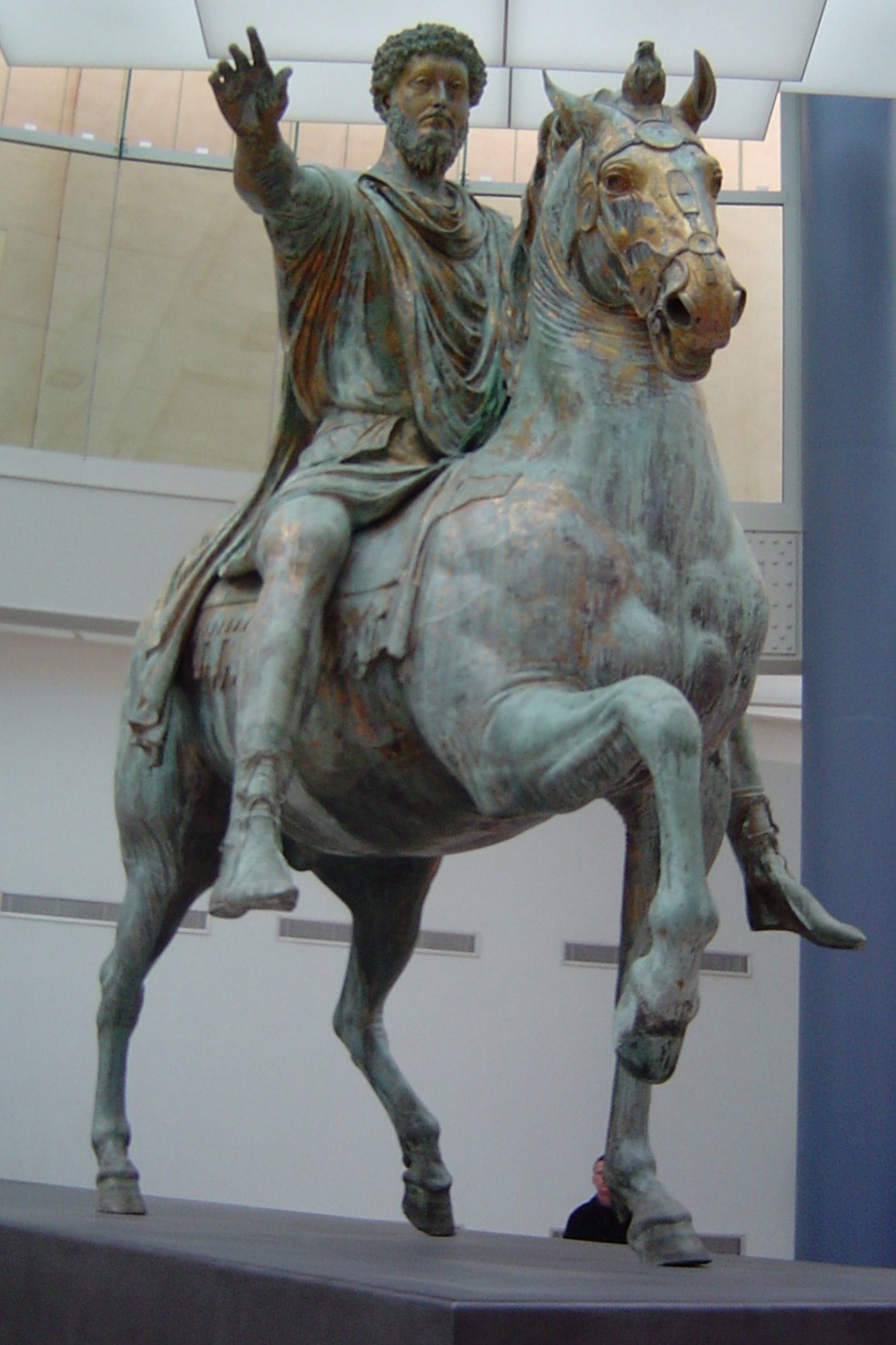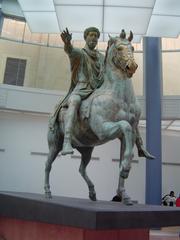
Equestrian Statue of Marcus Aurelius Rome: Visiting Hours, Tickets, and Travel Guide
Date: 14/06/2025
Introduction
The Equestrian Statue of Marcus Aurelius is one of Rome’s most iconic monuments, celebrated both for its artistic mastery and for its unique journey through history. Cast in bronze around 175 CE, it is the only surviving equestrian statue from ancient Rome, a testament to the city’s imperial grandeur and resilience. Due to a historical misidentification—believing it depicted Constantine the Great—it was spared during periods of destruction that claimed many pagan monuments (Porridge Magazine; ipl.org). Today, visitors can admire a faithful replica in the Piazza del Campidoglio, while the original masterpiece is preserved in the Capitoline Museums. This guide provides comprehensive historical context, detailed visitor information, and practical travel tips to help you experience one of Rome’s most enduring treasures (Capitoline Museums; Smarthistory; myadventuresacrosstheworld.com).
Historical and Artistic Significance
Origins and Legacy
Commissioned around 175 CE, the statue likely commemorated Marcus Aurelius’s military victories. Although the original location is uncertain, it is believed to have stood in a prominent public space such as the Roman Forum or near the Lateran Palace (Porridge Magazine). Its survival, unlike many other ancient bronzes which were melted down, is attributed to its mistaken identity as a Christian emperor.
Michelangelo’s Urban Vision
During the Renaissance, Michelangelo was commissioned by Pope Paul III to redesign Capitoline Hill, selecting the statue as the focal point of the newly envisioned Piazza del Campidoglio. This relocation underscored its importance as a symbol of civic power and artistic achievement (Smarthistory).
Conservation and Modern Display
By the 20th century, environmental factors threatened the statue’s integrity. In 1981, it was moved indoors to the Capitoline Museums for preservation, and a replica was installed in the piazza (ipl.org; Capitoline Museums). State-of-the-art conservation methods continue to protect this masterpiece.
Artistic Features
Standing 4.24 meters tall, the statue is crafted from bronze and was originally gilded with gold. Marcus Aurelius is depicted in a calm, commanding pose, extending his right hand in a gesture of clemency. The horse’s dynamic stance and the emperor’s serene expression reflect both military might and stoic philosophy (Porridge Magazine). The statue’s iconography and craftsmanship have influenced numerous equestrian monuments throughout history.
Visitor Information
Location
- Piazza del Campidoglio, Capitoline Hill, Rome
- The outdoor replica is at the heart of the piazza, while the original is displayed inside the Capitoline Museums’ Palazzo dei Conservatori (myadventuresacrosstheworld.com; museicapitolini.org).
Getting There
- By Foot: Easily accessible from the Roman Forum, Colosseum, and Piazza Venezia.
- Metro: Colosseo (Line B), then a 10-minute walk.
- Bus: Routes 85, 83, 81, 63, 30, 44 stop at Teatro Marcello/Ara Coeli.
Piazza del Campidoglio
- Open 24/7; free access.
- Features the replica statue, Renaissance architecture, and panoramic city views.
Capitoline Museums
- Hours: Tuesday–Sunday, 9:30 am–7:30 pm (last entry 6:30 pm); closed Mondays and select holidays (toorists.com).
- Tickets: ~€15 for adults, discounts for EU citizens under 25, children under 6 free. Advance booking is recommended, especially during peak season (toorists.com).
- Facilities: Lockers, restrooms, café, bookshop.
- Accessibility: Fully equipped for visitors with disabilities, including ramps and elevators.
Museum Experience
- The original statue is displayed in a glass-enclosed, naturally lit hall with multilingual information panels (museicapitolini.org).
- Guided tours and audio guides are available for deeper insights.
Practical Tips
- Visit in early afternoon or on weekdays for smaller crowds.
- Non-flash photography is permitted (check for specific restrictions in special exhibitions).
- The terrace behind Palazzo Senatorio provides excellent views over the Roman Forum.
Frequently Asked Questions (FAQ)
Q: Can I see the original statue outside?
A: No, only the replica is outdoors. The original is safeguarded inside the Capitoline Museums.
Q: Do I need tickets to view the statue?
A: Tickets are needed for the museum; the outdoor replica is free to view.
Q: Is the museum accessible?
A: Yes, the Capitoline Museums and the piazza offer full accessibility.
Q: Are guided tours available?
A: Yes, guided tours and audio guides provide expert commentary.
Q: Can I take photos?
A: Photography is allowed outside and generally inside the museum without flash.
Nearby Attractions
- Roman Forum & Palatine Hill: Short walk from Capitoline Hill.
- Piazza Venezia & Victor Emmanuel II Monument: Nearby civic landmarks.
- Other Museum Highlights: Gilded Hercules, Colossus of Constantine remains.
Cultural Significance
The Equestrian Statue of Marcus Aurelius is a symbol of imperial Rome, Renaissance civic ideals, and contemporary heritage conservation. Its image has appeared on Italian currency, including the 10,000 Lira note and the €0.50 coin. Museum shops offer related books and souvenirs (myadventuresacrosstheworld.com).
Essential Information
- Location: Piazza del Campidoglio, Capitoline Hill, Rome
- Hours (Museum): 9:30 am – 7:30 pm (last entry 6:30 pm), closed Mondays
- Tickets: ~€15 (discounts available)
- Official Info: Capitoline Museums Official Site
- Public Transport: Metro Line B (Colosseo); various buses to Teatro Marcello/Ara Coeli
- Accessibility: Fully accessible
- Facilities: Restrooms, café, lockers, shop
Summary and Final Tips
The Equestrian Statue of Marcus Aurelius remains a powerful emblem of Rome’s enduring legacy. Its survival through centuries of upheaval, careful conservation, and prominent placement within Michelangelo’s piazza offer visitors a compelling journey through art, history, and philosophy. For a richer experience, consider joining a guided tour, explore the surrounding historic sites, and check official channels for the latest visiting information (ipl.org; Capitoline Museums; Smarthistory; myadventuresacrosstheworld.com).
To further enrich your trip, download the Audiala app for guided tours, follow us on social media, and explore related posts on Roman monuments.
Sources and Further Reading
- Porridge Magazine: The Equestrian Statue of Marcus Aurelius — A Hero Over the Regal Complacency
- IPL: Object Analysis—The Equestrian Statue Of Marcus Aurelius
- Smarthistory: Equestrian Sculpture of Marcus Aurelius
- myadventuresacrosstheworld.com: Capitoline Hill Rome Guide
- Capitoline Museums: Official Website and Statue Information


















































































































































































































































